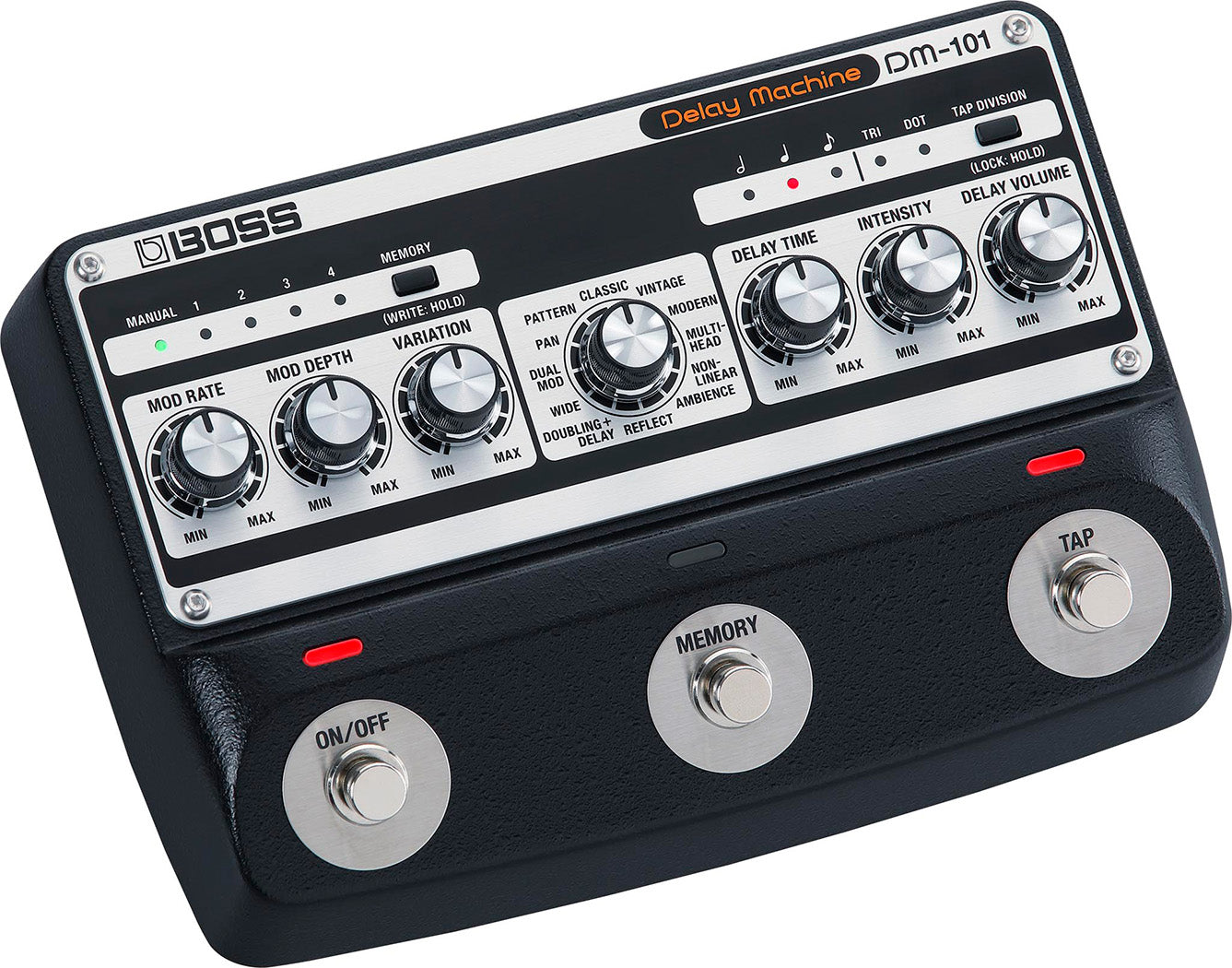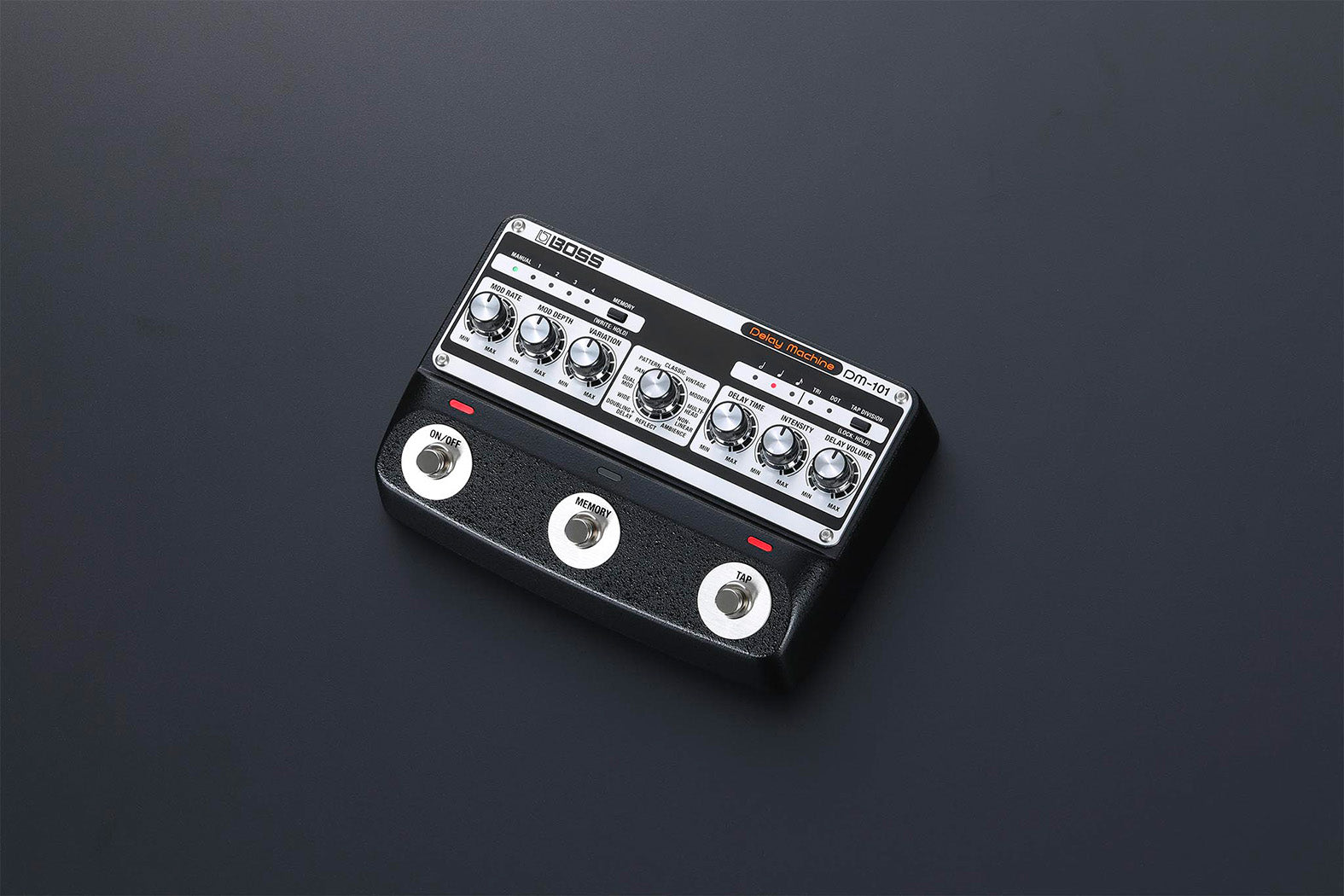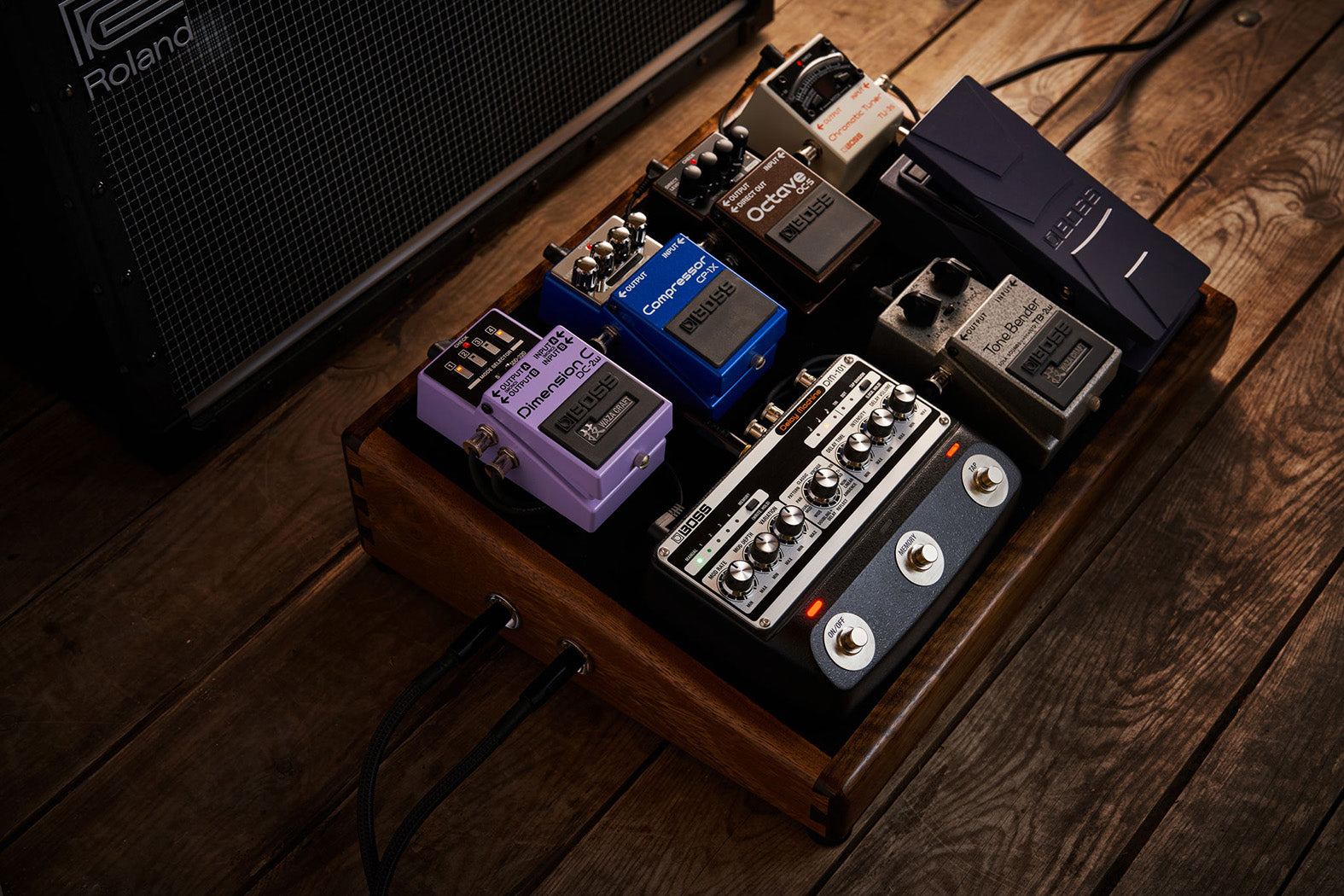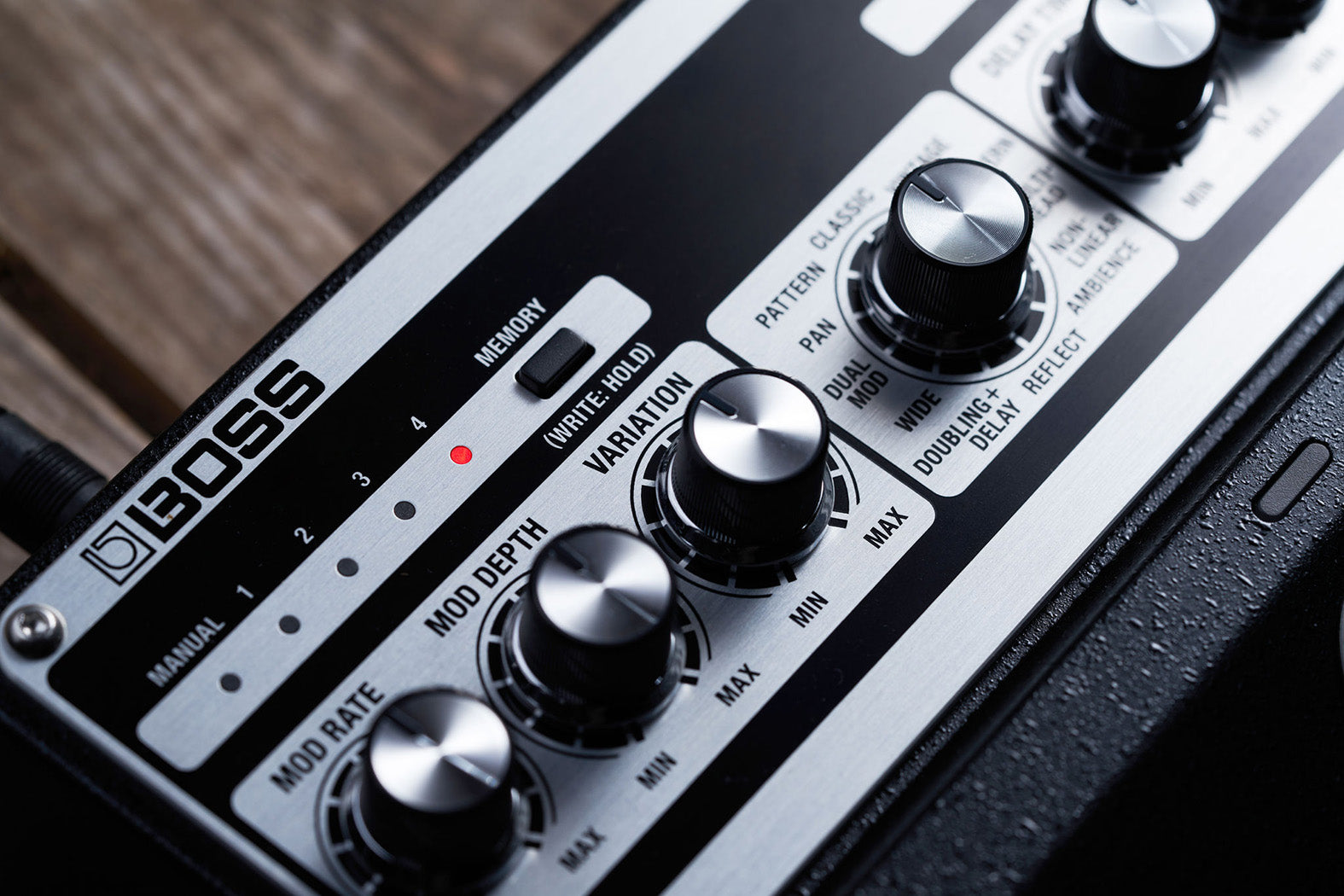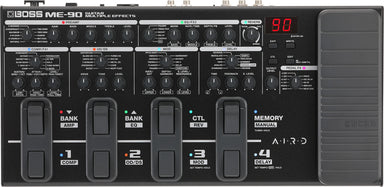
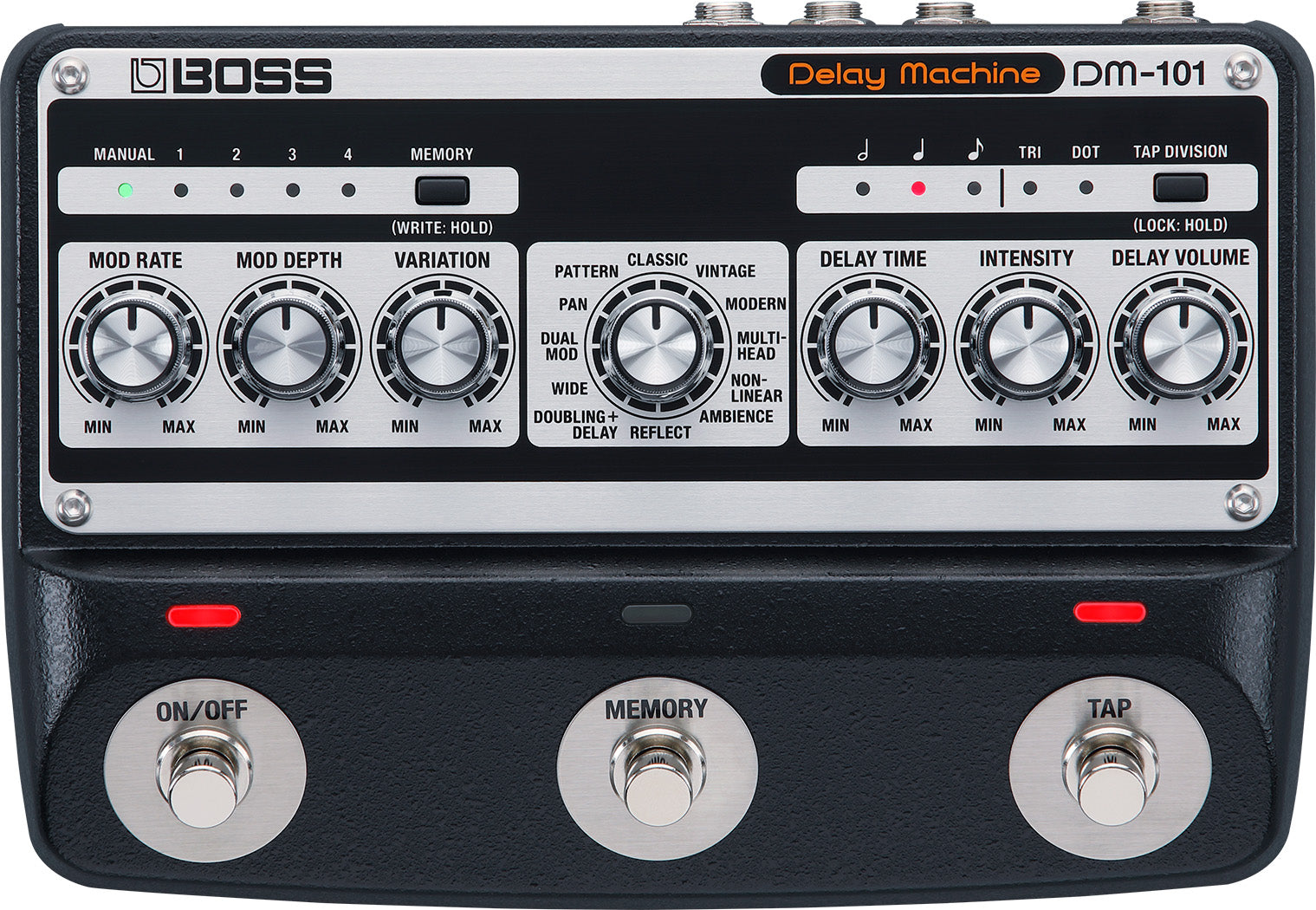
Meet the Ultimate Analog Delay
Classic sound meets modern power with the DM-101 Delay Machine, the ultimate analog delay. Driven by eight BBDs under smart CPU control, this inspiring pedal delivers 12 unique modes, stereo operation, and a wide array of tonal colors, all while maintaining 100 percent analog signal processing throughout. And with 127 user memories, tap tempo, carryover, MIDI, and more, the DM-101 brings you the features and versatility of an advanced digital pedal—but with the vibrant, characterful sound that’s only possible with authentic analog BBD circuitry.
Standard Features
- The ultimate analog delay pedal realized with advanced BOSS technology
- Fully analog BBD audio circuitry shaped by precision digital CPU control
- Warm, saturated, and highly musical tone
- Twelve modes deliver a wide range of mono and stereo delay textures, created using up to eight internal BBDs
- Stereo output with flexible signal routing options
- Adjustable modulation rate and depth with dedicated knobs
- Variation knob for controlling multiple parameters that are unique to each mode
- Selectable carryover for maintaining delay trails when the effect is bypassed
- MIDI I/O on mini TRS connectors
- Tap tempo function and tap division switch for creating rhythmic delays
- Four onboard memories plus the current panel settings
- 127 user memories accessible via MIDI program change
- Expandable control via external footswitches, an expression pedal, or MIDI
Analog Delay for the 21st Century
Analog delays based around BBD (bucket-brigade device) microchips emerged in the 1970s as a compact and cost-effective alternative to the standard tape delays of the era. Their warm, saturated, and highly musical sound established a distinctive style of delay that remains favored by many musicians and audio engineers. Leveraging modern CPU control, the DM-101 supercharges this classic effect with enhanced capabilities for today’s music makers.

Next-Level Performance with BOSS Innovation
The DM-101 takes the analog delay where it’s never gone before, providing access to cleaner sounds and extended delay times alongside traditional tones. To achieve this versatility, we used eight 2048-stage BBDs instead of the more common 4096-stage BBD. By finely tuning the behavior of these smaller BBDs with targeted CPU control, we can realize a far greater range of sound while retaining all the desirable analog characteristics that players love about their favorite BBD stomps.

Sounds from Vintage to Modern
The DM-101 flows effortlessly between gritty vintage echoes and modern analog delay tones with extended high-frequency clarity. Multiple internal circuit elements are switched to define each of the 12 modes, including the number of active BBDs and their connection order, low-pass filter settings, and clocking rates. Twisting the Variation knob cycles through parameters unique to the different modes. And you can always drive delays into saturated self-oscillation by cranking the Intensity knob.

Stereo Delays with True Analog Warmth
A major benefit of the DM-101’s CPU control is the ability to realize sophisticated stereo sounds not available with other BBD analog delays. For example, Pan mode routes each BBD and its feedback loop to alternate points in the stereo field, while Dual Mod shifts the modulation phase for each output to generate a wide, spacious delay effect. Six of the 12 modes support stereo operation, providing everything from short reverb-like sounds and expansive modulated delays to pattern delays for intense rhythmic effects.

Complete Creative Command
The DM-101 offers all the creative benefits you expect from an advanced delay pedal. Tap tempo and note subdivisions are available with most modes, and there’s carryover for maintaining repeats when the effect is bypassed. You can store and recall favorite setups with four onboard memories and connect up to two footswitches or an expression pedal for extended real-time control. MIDI I/O takes things further, providing remote access to 127 user memories, MIDI sync, and more. The audio outputs are set for blended operation by default, but they can be easily reconfigured for wet/dry rigs and wet-only parallel setups.

DM-101 Delay Modes
Classic—Traditional warm analog delay sound extended with up to 1200 ms of delay time. Adjust the modulation behavior by cycling through triangle, sine, and more complex waveform shapes with the Variation knob.
Vintage—Retro analog delay sound inspired by the iconic BOSS DM-2 Delay pedal introduced in 1981. Adjust the modulation behavior by cycling through triangle, sine, and more complex waveform shapes with the Variation knob.
Modern—Uniquely clear analog delay sound with a distinctive high-end tone and up to 840 ms of delay time. Adjust the modulation behavior by cycling through triangle, sine, and more complex waveform shapes with the Variation knob.
Multi-Head—Emulates a multi-head tape delay while imparting a uniquely analog BBD sound character. Use the Variation knob to cycle through 10 different head combinations.
Non-Linear—A unique effect that produces consecutive short delays (35–190 ms) that gradually increase in volume. The Variation knob allows you to control the delay times after the initial delay.
Ambience—Simulates a small space. Change the size and early reflections with the Variation knob.
Reflect—A stereo delay sound that produces a reverb-style effect. Adjust the pre-delay with the Variation knob.
Doubling+Delay—A stereo effect that combines a doubled sound with a longer delay. Use the Variation knob to balance the two sounds across the stereo output.
Wide—A stereo delay with offset left/right delay times for an expansive sound. Use the Variation knob to adjust the delay offset amount.
Dual Mod—A stereo delay with different modulation phase settings on the left and right outputs. Use the Variation knob to adjust the phase amount (the phase is fully inverted at the maximum setting).
Pan—A tapped stereo delay with different delay times distributed across the sound field. Use the Variation knob to fine-tune the delay time amounts.
Pattern—Stereo delay with different rhythmic patterns. Use the Variation knob to choose from the 10 available pattern types.
Product Gallery
Guide/Articles

BOSS 50TH ANNIVERSARY 1973 - 2023
Since 1973, BOSS has pioneered the development of unique and innovative products for guitarists everywhere. From class-leading effects pedals, multi-effects, and Loop Stations to guitar synthesizers, amplifiers, and more, our trailblazing designs include several world firsts and have forever changed the way people make music.Read more…

USING DELAY FOR SPECIFIC GENRES
Whether you're seeking crisp echoes, tape saturation, or subtle analog delays for a slapback effect, here are genre tips for every style.Read more…

USING A DELAY PEDAL WITH OTHER INSTRUMENTS
Delay pedals aren't solely for guitars. Learn why using this effect with other instruments is a gateway to fresh sonic landscapes.Read more…

EXPLORING THE DIFFERENCES BETWEEN BOSS DELAY PEDALS
Explore the differences between BOSS delay pedals so you can decide which BOSS delay is perfect for your sound and playing style.Read more…

COMPARING ANALOG AND DIGITAL DELAY PEDALS
Learn the differences between analog and digital delay guitar pedals and how to best utilize them in your setup.Read more…

THE DELAY PEDAL GLOSSARY
Explore this comprehensive delay pedal glossary to learn about attack, feedback, wow, flutter, and everything in between.Read more…
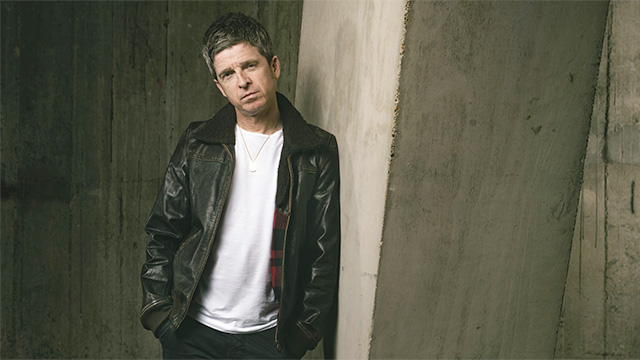
REVERBERATIONS: NOEL GALLAGHER
The Manchester master tunesmith opens up about the magic of guitar, the role of effects, and his endless search for melodies.Read more…

PEDAL PARTNERS: COMBINING VIBRATO WITH OTHER EFFECTS
Vibrato works for everything from gentle chorus to extraterrestrial sounds. Use it to create wild tones and tasteful classics.Read more…

PEDAL PARTNERS: COMBINING COMPRESSION WITH OTHER EFFECTS
The compressor pedal is a brilliant tool to enhance a guitar tone. Learn to get the most from this dynamic pedalboard mainstay.Read more…

THE COMPLETE GUIDE TO DELAY PEDALS
This in-depth guide features everything a guitarist needs to begin their journey—from the origins of delay to complex setups.Read more…




